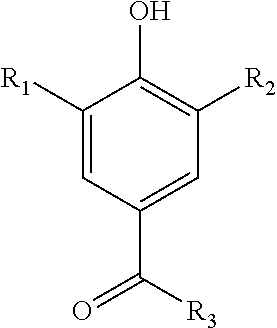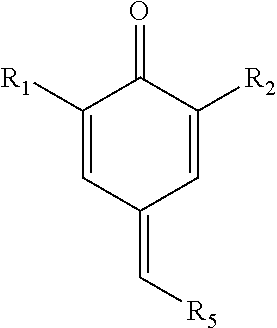Synthesis of 7-acetyleno quinone methide derivatives and their application as vinylic polymerization retarders
a technology of 7-acetyleno quinone and methide, which is applied in the field of synthesizing 7-acetyleno quinone methide, can solve the problems of product loss, undesirable polymerization of monomers, and particularly problematic undesired thermal polymerization
- Summary
- Abstract
- Description
- Claims
- Application Information
AI Technical Summary
Benefits of technology
Problems solved by technology
Method used
Image
Examples
example 1
Synthesis of 2,6-di-tert-butyl-4-(3-phenylprop-2-ynylidene)cyclohexa-2,5-dienone (7-Phenylacetyleno Quinone Methide (7-Phace-QM))
(a) 2,6-di-tert-butyl-4-(piperidin-1-ylmethylene)cyclohexa-2,5-dienone
[0057]Into a 500 mL three-necked round-bottomed flask equipped with a Dean-Stark trap, a condenser, a magnetic stirring bar and a stopper, the following reagents were added; 24.3 g (100 mmoles) of 3,5-di-tert-butyl-4-hydroxybenzaldehyde and 150 mL of n-heptane. The flask was then armed with a dropping funnel charged with 21.7 mL (200 mmoles) of piperidine.
[0058]A heating block was used to heat the n-heptane slurry of 3,5-di-tert-butyl-4-hydroxybenzaldehyde at 140° C. The slurry was heated for 30 minutes. To the flask, piperidine was added dropwise. Roughly 2 mL of water, the byproduct of the condensation reaction, was removed by azeotropic distillation using a Dean-Stark trap.
[0059]In further experiments, the initial dehydration of 3,5-di-tert-butyl-4-hydroxybenzaldehyde before the addit...
example 2
[0070]A comparison of the performances was made between a sample of a prior art retarder, 7-phenyl-quinone methide, and a sample of the inventive retarder, 7-phenylacetyleno-quinone-methide. A sample of each retarder was added at a dosage of 100 ppm relative to monomer weight. Each of the samples of retarders was placed in a continuously stirred tank reactor that simulates the reboiler of a distillation tower prone to polymerization fouling during a shutdown. Each sample was heated to 120° C. and underwent a 0.5-hour residence. The prior art sample resulted in 6429 ppm of unwanted polymer while the inventive retarder only had 4236 ppm of unwanted polymer. This demonstrates that the inventive retarder has a superior performance compared to prior art retarder.
[0071]Compared to DNBP, 7-acetylenic quinone methides are known to be less toxic. Not only are the inventive retarders safer but they also belong to a class of compounds with a history of use as oral and subcutinaceous drugs. Aga...
PUM
| Property | Measurement | Unit |
|---|---|---|
| temperature | aaaaa | aaaaa |
| temperature | aaaaa | aaaaa |
| temperature | aaaaa | aaaaa |
Abstract
Description
Claims
Application Information
 Login to View More
Login to View More - R&D
- Intellectual Property
- Life Sciences
- Materials
- Tech Scout
- Unparalleled Data Quality
- Higher Quality Content
- 60% Fewer Hallucinations
Browse by: Latest US Patents, China's latest patents, Technical Efficacy Thesaurus, Application Domain, Technology Topic, Popular Technical Reports.
© 2025 PatSnap. All rights reserved.Legal|Privacy policy|Modern Slavery Act Transparency Statement|Sitemap|About US| Contact US: help@patsnap.com



